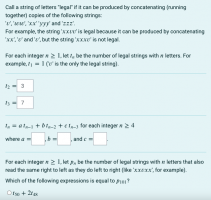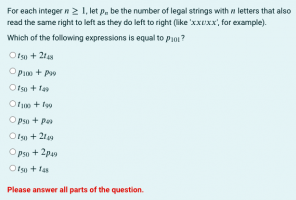I've been stuck on this recursion question for about 2 days now and still can't find a way to solve the following. I've managed to find what t2 and t3. I've tried to solve a, b and c using simultaneous equations by first finding t4, t5 and t6, and got the answers: a = -11, b = 41 and c = -31. But I'm totally sure that my answers are wrong. And the method I've used to find t4, t5 and t6 seems a bit redundant and long. So I'm wondering if there's an alternative and perhaps correct way to solve this problem.
And as for the last multiple choice question, I'm really unsure about what the question is asking and how to find the answer.
Any help is appreciated! Thanks!


And as for the last multiple choice question, I'm really unsure about what the question is asking and how to find the answer.
Any help is appreciated! Thanks!


